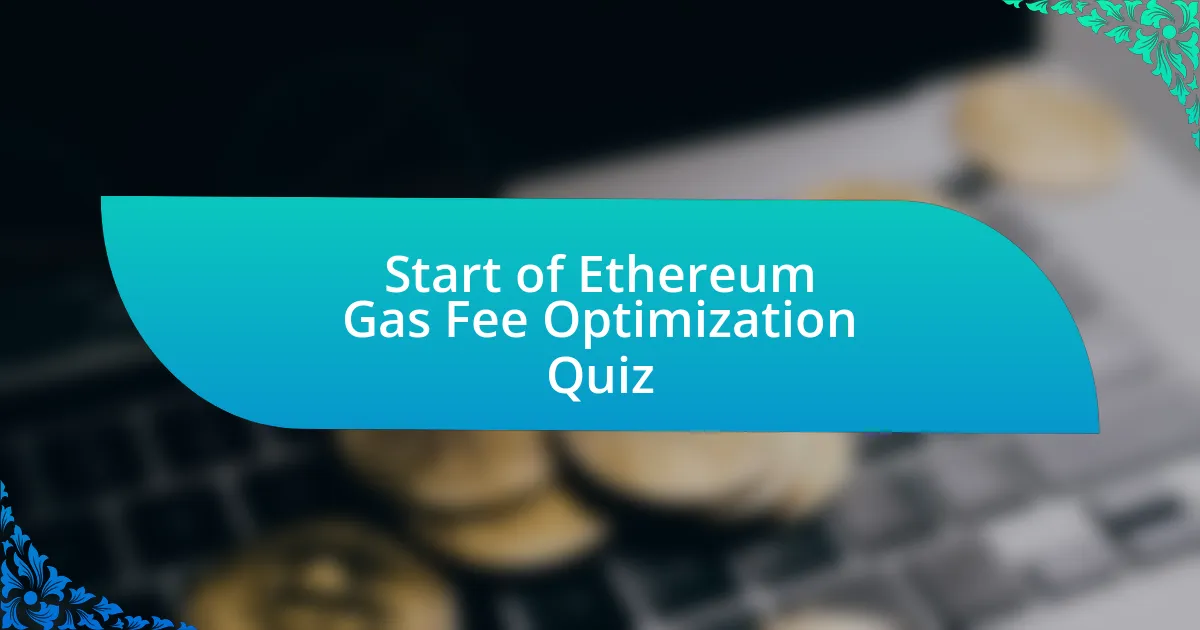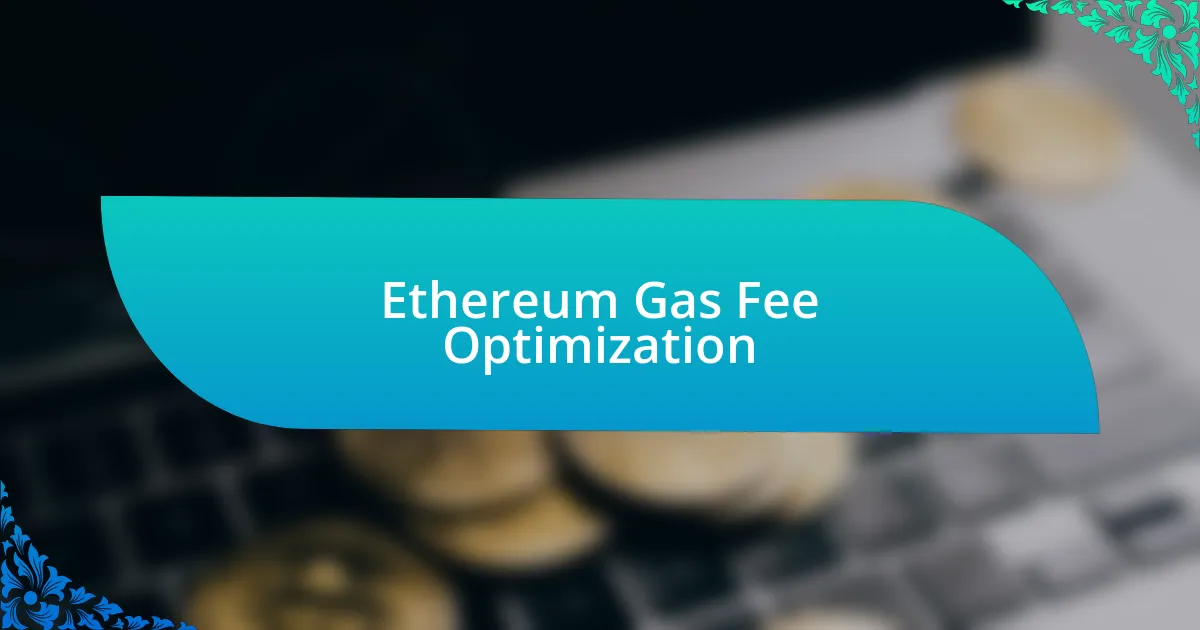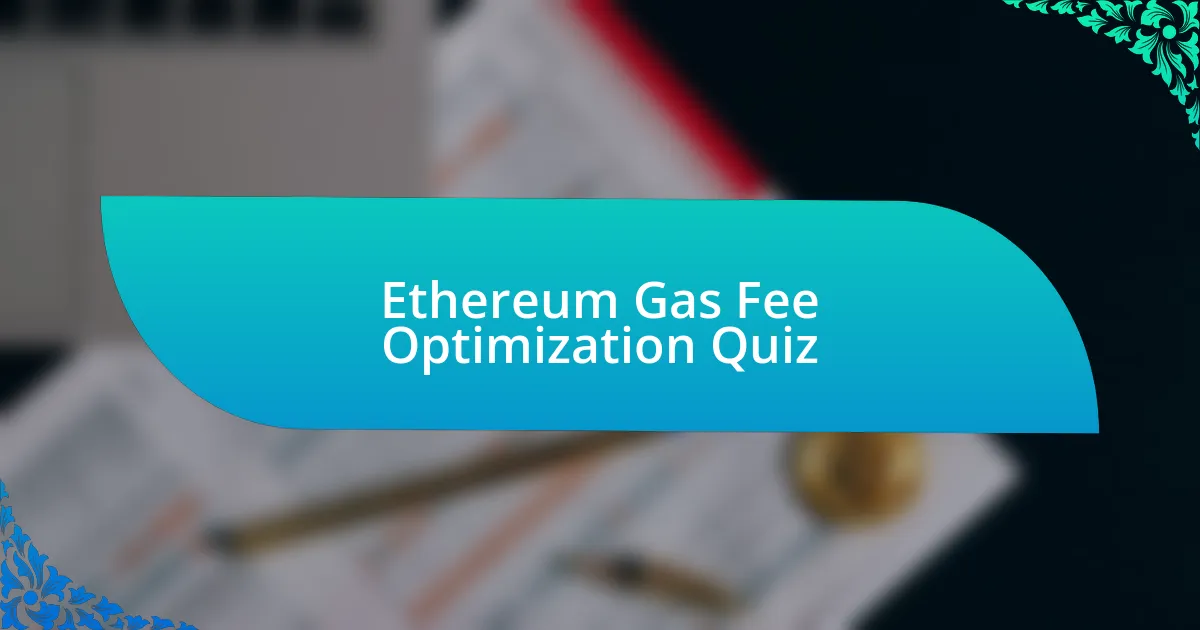
Start of Ethereum Gas Fee Optimization Quiz
1. What is Ethereum gas?
- The fee required to successfully conduct a transaction or execute a contract on the Ethereum blockchain platform.
- A type of digital currency used only for trading assets.
- A reward given to miners for validating transactions.
- A form of token used to secure Ethereum’s network.
2. How are Ethereum gas fees measured?
- In increments of 1 dollar for each transaction.
- In whole units of Bitcoin (BTC) based on market price.
- In tiny fractions of the cryptocurrency ether (ETH), known as gwei (10^-9 ETH).
- In percentages based on transaction size in gigabytes.
3. What is the base fee in Ethereum gas fees?
- A fixed fee that never changes regardless of network traffic.
- A maximum fee that users are willing to pay for a transaction.
- A mandatory minimum fee set by the network, which adjusts based on demand.
- A fee that is only applicable for urgent transactions.
4. What is the priority fee in Ethereum gas fees?
- A refund given to users for unused gas.
- A mandatory charge every user must pay.
- An optional fee added to the base fee for faster processing.
- A fixed fee that does not change with demand.
5. How do you calculate gas fees?
- Using the formula: Units of Gas Used * (Base Fee + Priority Fee).
- Adding the total number of tokens to the gas price.
- Multiplying gas limit by the transaction value.
- Dividing the total ETH by the number of transactions.
6. What is the role of the gas limit in Ethereum transactions?
- It represents the maximum amount of gas a user is willing to spend on a transaction.
- It measures the speed of transaction confirmation.
- It indicates the minimum amount of tokens for a transaction.
- It tracks the number of active users on the network.
7. How can you reduce Ethereum gas fees?
- By using Layer 2 solutions.
- By conducting transactions during peak hours.
- By avoiding gas tokens.
- By increasing the transaction size.
8. What are some tools for monitoring gas fees?
- ETH Gas Station
- Gas Alert Pro
- Gas Nowhere
- Fuel Monitor
9. How does Ethereum 2.0 affect gas fees?
- It sets a fixed gas price for all transactions, ensuring uniform costs.
- It eliminates gas fees altogether for all users on the platform.
- It permanently lowers gas fees by increasing transaction speed across the network.
- It does not directly reduce gas fees, as fees are mainly a function of network demand and block space availability.
10. What are some strategies to avoid high Ethereum gas fees?
- Choosing off-peak hours, using Layer 2 solutions, and setting a lower gas limit for non-urgent transactions.
- Always using the maximum gas limit regardless of urgency.
- Sending transactions multiple times in a row to increase visibility.
- Ignoring transaction speed altogether to save on fees.
11. What is the difference between gas and block rewards in Ethereum?
- Gas fees reward miners, while block rewards pay for transactions.
- Gas fees apply to Layer 2 solutions, block rewards do not exist.
- Gas fees are for storing data, while block rewards pay users.
- Gas fees pay validators for transactions; block rewards incentivize miners.
12. How do gas tokens help in reducing Ethereum gas fees?
- By minting tokens when gas prices are low and using them to cut down Ethereum gas charges during peak periods.
- By allowing users to borrow ether without gas fees during high demand periods.
- By automatically adjusting the gas price to a flat rate for all transactions on the network.
- By providing rebates to users on every transaction conducted on the Ethereum network.
13. What are some popular gas fee estimation tools?
- ETH Gas Station
- Gas Tracker
- BTC Gas Monitor
- Ether Fee Reader
14. How do Layer 2 solutions reduce Ethereum gas fees?
- By increasing the block size limit, allowing more transactions to be included in each block.
- By introducing new cryptocurrencies to compete with Ethereum, which drives gas fees down.
- By requiring higher fees for faster transaction processing, which discourages network congestion.
- By processing transactions off the main Ethereum chain, which decreases the demand on Ethereum’s mainnet and lowers gas fees.
15. What are the advantages of using Layer 2 solutions?
- Higher transaction fees, slower processing times, and decreased efficiency.
- Eliminates the need for gas fees entirely, making transactions free.
- Only improves security, without any effect on costs or speed.
- Reduced gas fees, increased transaction speed, and enhanced scalability.
16. Which Layer 2 technologies are prominent in reducing Ethereum gas fees?
- Optimistic Rollups and Zero-Knowledge (ZK) Rollups
- Sidechains and State Channels
- Hard Forks and Proof-of-Stake
- Merkle Trees and Proof-of-Work
17. How does batching transactions reduce Ethereum gas fees?
- By increasing the base fee for more efficient processing of each transaction.
- By allowing users to set arbitrary gas fees for each transaction individually.
- By combining multiple transactions into one, which can save on gas fees and improve processing times.
- By sending transactions during peak hours to prioritize them.
18. What is the benefit of using constants and immutable variables in Solidity smart contracts?
- It enhances the readability of smart contract code for developers.
- It reduces gas costs by minimizing storage space consumption within the Ethereum Virtual Machine.
- It allows for the dynamic modification of contract states during execution.
- It increases the flexibility of variable types in smart contracts.
19. How can you optimize on-chain data in Solidity smart contracts?
- By increasing the gas limit for all transactions to handle more data.
- By using events for storing off-chain data instead of using on-chain data storage options.
- By creating multiple contracts for each data type to distribute the load.
- By adding more complexities in contracts to enhance processing speed.
20. What is the role of the Test-And-Set operation in mitigating concurrency hazards in Ethereum?
- It increases the block size to allow more transactions.
- It eliminates the need for gas fees entirely.
- It ensures a fixed total-ordering of the transaction list.
- It doubles the transaction speed for all users.
21. How do miners maximize their profits in Ethereum?
- By focusing solely on the highest value transactions regardless of costs.
- By mining only during peak network congestion to increase gas prices.
- By accurately predicting both the income and cost from each transaction and selectively including messages that maximize their profits.
- By randomly selecting transactions without considering their profitability.
22. What is the impact of unused gas on Ethereum transactions?
- Unused gas gets permanently discarded and cannot be recovered.
- Unused gas is returned to the sender after a transaction completes.
- Unused gas is converted into Ether and sent to the miners.
- Unused gas has no significance and does not affect the transaction outcome.
23. How do gas-related income and costs affect miner profitability?
- Miners choose transactions based solely on their size, ignoring gas income and costs.
- Miners want to maximize their profits by selectively including messages that yield more gas income while minimizing CPU costs.
- Miners have no control over the income from transactions and must accept any gas fees.
- Miners receive fixed payments regardless of the gas fees collected from transactions.
24. What is the formula for calculating gas-related income for miners?
- Mining_Capacity * (Block_Fee + SIMPLE_Gas_Income).
- Hash_Rate * (Mining_Gains + TOTAL(Transaction_Gas)).
- Mining_Power_Fraction * (Block_Reward + SUM(Program_Gas_Income)).
- Mining_Efficiency * (Transaction_Value + AVERAGE(Mining_Revenue)).
25. How do gas limits and gas prices influence miner profitability?
- Gas limits have no effect on miner decisions regarding profitability.
- Miners make profitability decisions based on gas limits and prices to maximize income while controlling costs.
- Miners only focus on block rewards, ignoring gas limits and prices.
- Miners can choose any gas price without considering their impact on profit.
26. What is the relationship between gas consumption and program execution in Ethereum?
- Program execution consumes gas, and exceeding the gas limit results in termination.
- Gas is consumed only when transactions are confirmed and executed.
- Higher gas consumption speeds up program execution without limits.
- Gas consumption is unrelated to the program execution process in Ethereum.
27. How do gas tokens help in managing Ethereum gas costs?
- By eliminating gas fees entirely for all transactions on the Ethereum network.
- By increasing the cost of transactions during busy times to maintain network stability.
- By standardizing gas prices so that they do not fluctuate with demand.
- By allowing users to mint tokens when gas prices are low and use them to reduce gas charges during peak periods.
28. What are some strategies for optimizing smart contract interactions in Ethereum?
- Increasing transaction size, using outdated contracts, and avoiding gas fee estimation.
- Only relying on Layer 1 solutions, focusing on manual gas adjustments, and avoiding smart contract optimizations.
- Using constants and immutable variables, reducing on-chain data, and implementing gas fee estimation tools.
- Ignoring network congestion, batching transactions, and ensuring high gas limits.
29. How do gas monitoring tools help in optimizing Ethereum transactions?
- They are used to create new cryptocurrencies within the Ethereum network.
- They help in mining new blocks by enhancing transaction validation.
- They provide real-time gas price insights, helping users identify optimal transaction windows to minimize fees.
- They increase the block size for more transactions to be processed at once.
30. What is the benefit of using gas refund programs in Ethereum?
- They increase gas fees for faster transactions.
- They eliminate all gas fees for users permanently.
- They only apply to NFT transactions on Ethereum.
- They offer platforms like Balancer and KeeperDAO that can refund gas fees, reducing transaction costs.

Congratulations! You’ve Successfully Completed the Quiz
Thank you for participating in our quiz on Ethereum Gas Fee Optimization. We hope you found the questions engaging and thought-provoking. By exploring this topic, you’ve likely gained valuable insights into how gas fees work and the various strategies to optimize them. Understanding these concepts is crucial in navigating the Ethereum ecosystem effectively.
Throughout the quiz, you may have learned about different factors affecting gas fees, including network congestion and transaction complexity. You might now appreciate the importance of timing transactions and how to utilize tools to monitor gas prices. These skills are essential for anyone looking to engage with Ethereum more wisely.
We encourage you to continue your learning journey by checking out the next section on this page. It contains in-depth information that will further enhance your understanding of Ethereum Gas Fee Optimization. Expanding your knowledge will empower you to make more informed decisions in your crypto endeavors. Happy learning!

Ethereum Gas Fee Optimization
Understanding Ethereum Gas Fees
Ethereum gas fees are the costs associated with processing transactions or executing smart contracts on the Ethereum network. These fees are paid in Ether (ETH) and vary based on network congestion, transaction complexity, and miner demand. Each operation on the Ethereum blockchain requires computational resources, which is quantified in gas. Higher usage and demand lead to increased fees.
Factors Influencing Ethereum Gas Fees
Several factors influence Ethereum gas fees. Network congestion is the most significant factor; high demand for transactions results in elevated fees. Transaction complexity also plays a role; more complex transactions require more computational power and, consequently, more gas. Additionally, external events, such as DeFi activity or NFT launches, can spike gas fees temporarily due to increased network load.
Strategies for Optimizing Ethereum Gas Fees
Optimizing Ethereum gas fees involves several strategies. Users can time their transactions for periods of lower network congestion, typically during off-peak hours. Choosing a lower gas price can result in delayed transactions, but it reduces costs. Utilizing gas tracking tools helps monitor gas prices, enabling users to choose optimal moments for transaction execution.
Using Gas Tokens for Fee Reduction
Gas tokens can be used to reduce Ethereum gas fees by utilizing the network’s tax incentives. These tokens allow users to mint and redeem gas when prices are low, effectively storing gas credits for future transactions. By redeeming these credits during high gas fee periods, users can significantly lower their transaction costs.
Impact of Ethereum Upgrades on Gas Fees
Ethereum upgrades, particularly Ethereum 2.0 and EIP-1559, impact gas fees directly. EIP-1559 introduced a base fee mechanism that adjusts dynamically based on demand. This upgrade aims to stabilize gas fees and improve predictability. Future upgrades are planned to enhance scalability, which could further reduce gas fees by increasing transaction throughput on the network.
What are Ethereum gas fees?
Ethereum gas fees are the costs required to execute transactions or smart contracts on the Ethereum blockchain. These fees compensate miners for processing transactions and ensuring network security. Gas fees are determined by supply and demand; higher network congestion raises prices. For example, during peak usage times, fees can skyrocket, reaching upwards of $100 per transaction.
How can Ethereum gas fees be optimized?
Ethereum gas fees can be optimized by using strategies such as timing transactions during low network congestion, selecting lower gas price limits in wallets, and employing Layer 2 solutions like Optimistic Rollups or zk-Rollups. Additionally, batching transactions can reduce the overall fee expenditure. Practical examples include using gas trackers like GasNow to find the optimal time for transactions.
Where can users find tools for gas fee optimization?
Users can find tools for gas fee optimization on websites like GasNow, EthGasStation, and Etherscan. These platforms provide real-time data on gas prices and transaction speeds. Users can compare fees and select the most cost-effective timing for their transactions based on the information provided. Such tools enable informed decision-making to minimize gas costs.
When do Ethereum gas fees spike?
Ethereum gas fees typically spike during periods of high network activity, such as during major token launches, decentralized finance (DeFi) events, or NFT releases. Historical data shows that significant drops in Ether prices or increased user engagement in certain projects correlate with higher gas fees. For instance, the launch of NFTs like CryptoPunks often resulted in surges in gas prices due to high demand.
Who is affected by Ethereum gas fees?
Ethereum gas fees affect all users on the network, particularly those conducting frequent transactions, such as traders, developers, and DeFi participants. High fees can deter users from engaging with the network or executing trades. For example, small-scale investors may find the costs prohibitive, limiting their ability to participate in the ecosystem. This impact is evident in user behavior during periods of elevated fees.

